27 Best Tourist Attractions in Brazil, it is the fifth largest country in the world, stretches across half of South America. Along its 7,500 km (4,600 miles) coastline, you will find stunning white-sand beaches, tropical islands, vibrant cities filled with music, and charming colonial towns.
Venturing inland, Brazil offers breathtaking sights such as majestic waterfalls, wildlife-filled wetlands, and the untouched beauty of the Amazon rainforest, home to isolated tribes who have had no contact with the outside world.
As the largest country in Latin America, Brazil has a rich history as a former Portuguese colony for 300 years starting from 1500. The remnants of this colonial heritage can still be seen in the historic cities scattered throughout the country.
In addition to its cultural and natural wonders, Brazil is renowned for its picturesque beaches, perfect for surfing and admired for their scenic beauty. While some beaches are easily accessible in the Rio area, others require a thrilling adventure to reach. If you are planning a trip to this captivating country, we have compiled a list of the best things to do in Brazil.
Florianopolis Beaches
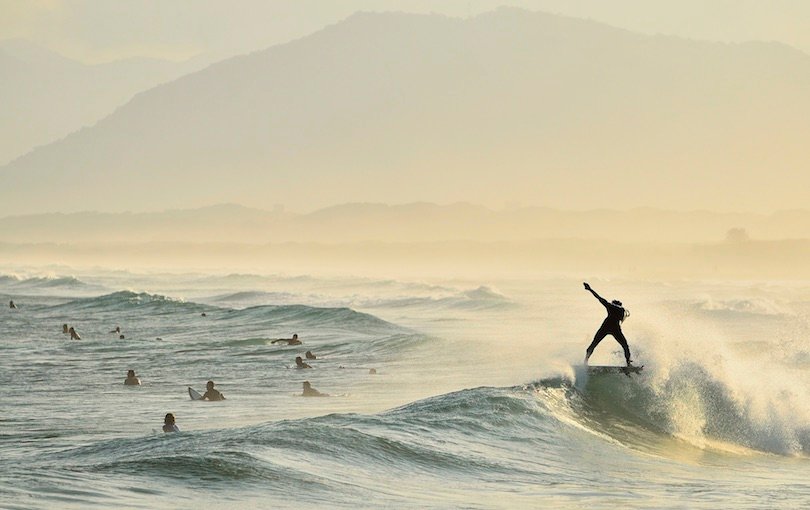
Florianopolis, also referred to as Floripa, is renowned for its 42 captivating beaches that attract surfers, party enthusiasts, and sun worshippers alike. Among these beaches, Joaquina stands out as a favorite due to its expansive sand dunes and impressive waves. However, in recent times, its neighboring beach, Praia Mole, has been gaining popularity, somewhat overshadowing Joaquina’s fame.
For travelers who seek to mingle with the affluent and famous, Jurere is the ideal destination. This beach boasts extravagant residences and some of the finest nightclubs in the region. On the other hand, those yearning for tranquility and seclusion should venture to Lagoinha do Leste. It is worth noting that reaching this beach requires a two-hour hike.
Praia de Pipa

Praia de Pipa, renowned for its picturesque beaches, towering cliffs, and pristine waters, has emerged as a prominent beach getaway in Brazil, captivating the hearts of both residents and travelers alike. Moreover, this charming town is celebrated for its lively nightlife and presents a plethora of recreational options, such as boating and surfing, to its visitors.
Despite its popularity, the town is constrained by its location within Environmental Protected Areas, which limits its size. However, this also means that visitors can fully appreciate the natural splendor of the region and take a dip in the waters that are home to an abundance of dolphins and turtles.
Museu de Arte Contemporanea
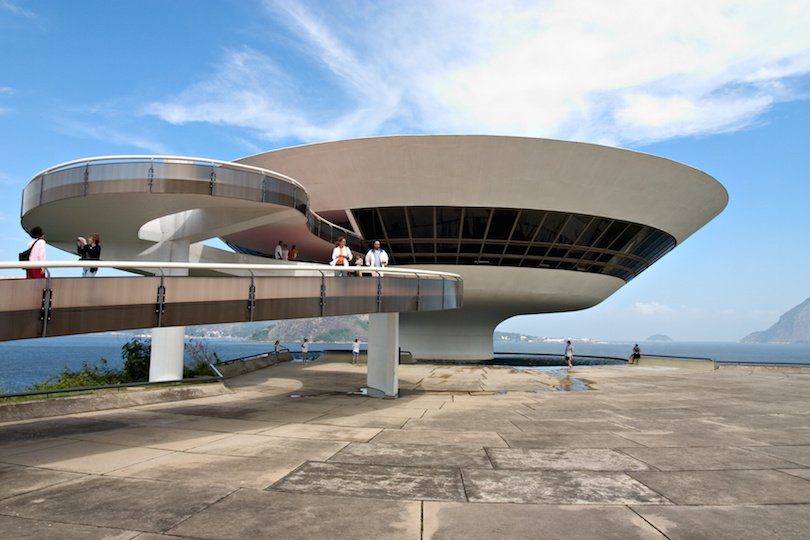
Museu de Arte Contemporânea de Niterói (MAC), or Niterói Contemporary Art Museum, is well-known for its peculiar architecture, similar to an alien spaceship, that draws in visitors from across the globe.
One of the featured landmarks of the city of Niterói, near Rio de Janeiro, the museum’s unique structure was designed by famous Brazilian modernist architect Oscar Niemeyer. The architect, Niemeyer, was one of the main leaders of the Brazilian modernist movement, with Museu de Arte Contemporânea de Niterói being one of his more well-known works.
The museum’s location features breathtaking viewpoints of Guanabara Bay, and inside the museum are panoramic views of the bay, Ripe de Janeiro, and Sugar Loaf Mountain. Visitors will also find a diverse array of contemporary art pieces on display to view.
Buzios is one of the 27 Best Tourist Attractions in Brazil

Buzios, also known as Armação dos Búzios, is a charming coastal town that holds a special place in the hearts of both locals and tourists. Its pleasant climate, picturesque beaches, and crystal-clear waters create an idyllic setting for a memorable vacation.
Situated northeast of Rio de Janeiro, Buzios boasts a plethora of stunning beaches to suit every preference. Whether you prefer to bask in the tropical weather, unwind on the sandy shores, or immerse yourself in the vibrant atmosphere of Brazil’s Costa do Sol, Buzios offers it all.
At the heart of Buzios lies Rua das Pedras, a lively street adorned with cobblestones, boutique shops, delightful restaurants, cozy cafes, and trendy nightclubs that come alive after sunset. For a romantic evening, take a leisurely stroll along the Orla Bardot Boardwalk, which connects Rua das Pedras to Armacao Beach. As you walk hand in hand, you’ll have the opportunity to admire the renowned statues created by the talented artist Christina Motta.
Aparados da Serra National Park
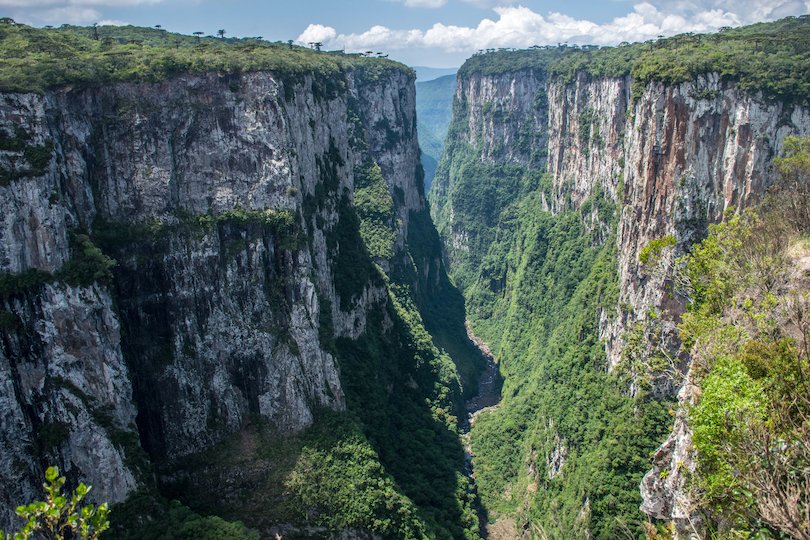
Aparados da Serra, one of Brazil’s earliest national parks, was established to safeguard Itaimbezinho, one of the country’s most stunning canyons. The canyon, which is surrounded by subtropical forest, has nearly 720 meters (2360 feet) of sheer parallel escarpments. Two waterfalls flow into a stone plunge pool that empties into the Rio do Boi, which meanders through the canyon’s bottom. Although a steep rocky path leads from the canyon rim to the river, it is a challenging and hair-raising trek that should not be taken lightly.
Cathedral of Brasilia
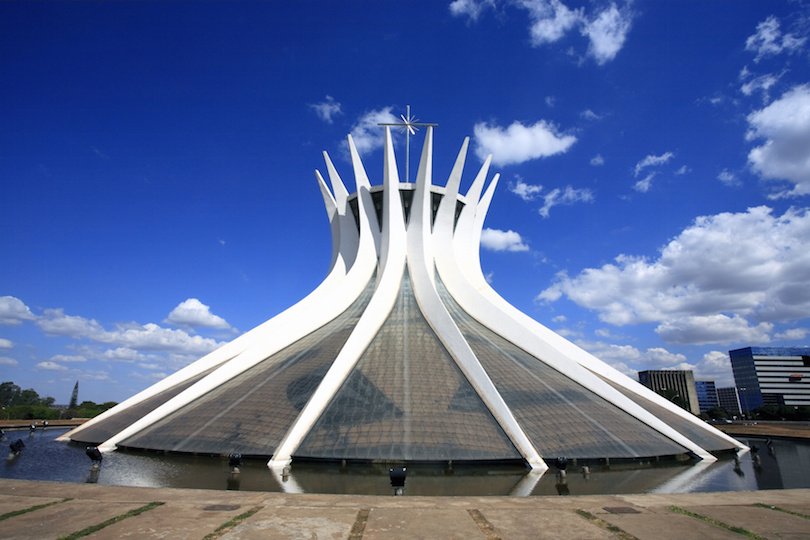
The Cathedral of Brasilia, located in the capital of Brazil, serves as the headquarters of the Archdiocese of Brasilia. Designed by renowned Brazilian architect Oscar Niemeyer, this Roman Catholic church was finished in 1970. It features a distinctive crown-shaped design and an awe-inspiring stained glass ceiling.
The Cathedral of Brasilia boasts four magnificent bronze sculptures at its entrance, each standing at an impressive height of almost ten feet. These sculptures symbolize the four Evangelists: Matthew, Mark, Luke, and John.
Inside the cathedral, there are three angel sculptures suspended above the congregation, varying in height from 7 to 14 feet. The altar, a generous gift from Pope Paul VI, graces the interior of the Cathedral of Brasilia, while the bell tower houses four bells donated by Spain.
Visiting the Cathedral of Brasilia is a highly popular activity, allowing visitors to appreciate its modern architecture and design, which undoubtedly exudes a remarkable charm.
Pelourinho
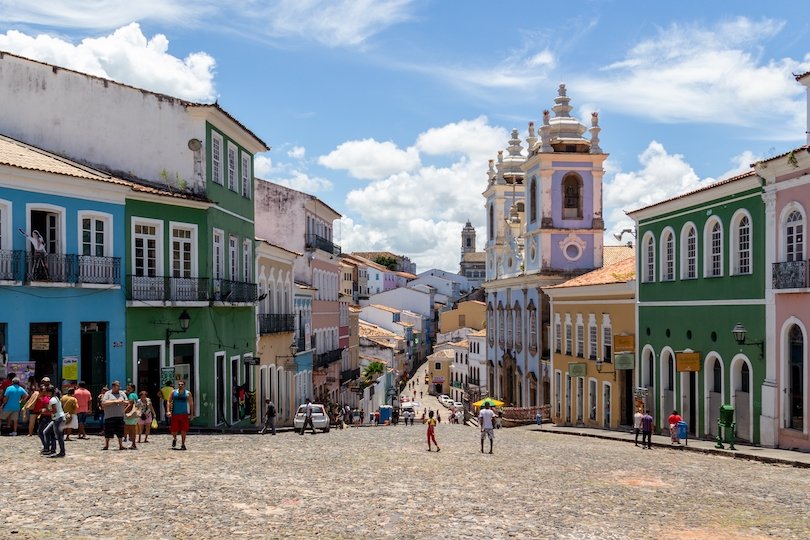
During the colonial era, the Pelourinho neighborhood in western Salvador, Bahia, served as the bustling heart of the city. It played a significant role as a slave market until the abolition of slavery in 1835.
In the present day, Pelourinho has transformed into a thriving center brimming with cultural richness, historical significance, and countless opportunities to delve into the captivating world of colonial architecture.
Within Pelourinho, there are numerous remarkable attractions that cater to the interests of tourists. One such attraction is the Igreja de São Francisco, a magnificent church dating back to the early 18th century. This architectural marvel showcases the grandeur of the High Baroque style, adorned with intricate artwork that evokes a sense of wonder. The opulent gold-covered ceilings further enhance its splendor, leaving visitors in awe of its beauty.
Witness a captivating live capoeira demonstration. Capoeira, an Afro-Brazilian martial art, seamlessly blends music, acrobatics, dance, and spirituality, accompanied by traditional Brazilian melodies and instruments. Observing the awe-inspiring showcases of intricate spins and powerful kicks is a truly enchanting encounter, offering a glimpse into the captivating history of Afro-Brazilian heritage.
Moreover, Pelourinho boasts a plethora of other captivating cultural activities and attractions, each offering a unique opportunity to delve into the vibrant tapestry of its rich history.
Ilha Grande
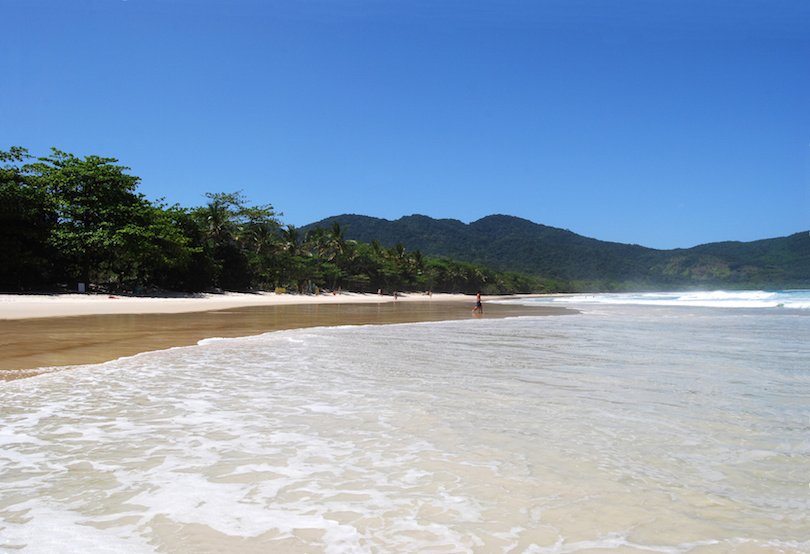
Ilha Grande, situated between Sao Paulo and Rio de Janeiro, is a captivating and sought-after destination for a weekend escape. With its lush forest trails perfect for hiking, pristine waters ideal for swimming, and picturesque white-sand beaches that invite relaxation, it’s no wonder that time seems to slip away effortlessly while vacationing on this island.
In the past, Ilha Grande served as a state prison, a leper colony, and a haven for pirates. However, today it has transformed into an idyllic vacation spot, attracting both locals and tourists who seek solace, rejuvenation, and outdoor activities.
Embark on a mesmerizing hike to Lopes Mendes Beach, renowned as one of Brazil’s most frequently acclaimed beaches. Its unending coastline, tranquil ambiance, and crystal-clear waters emanate a serene atmosphere that envelops visitors. Moreover, Ilha Grande offers numerous hiking trails for those who crave thrilling adventures.
Hike near Vila de Abraao, passing the old prison that housed political prisoners, or hike to the island’s highest point, Pico de Papagayo, for a challenge.
Chapada dos Veadeiros National Park
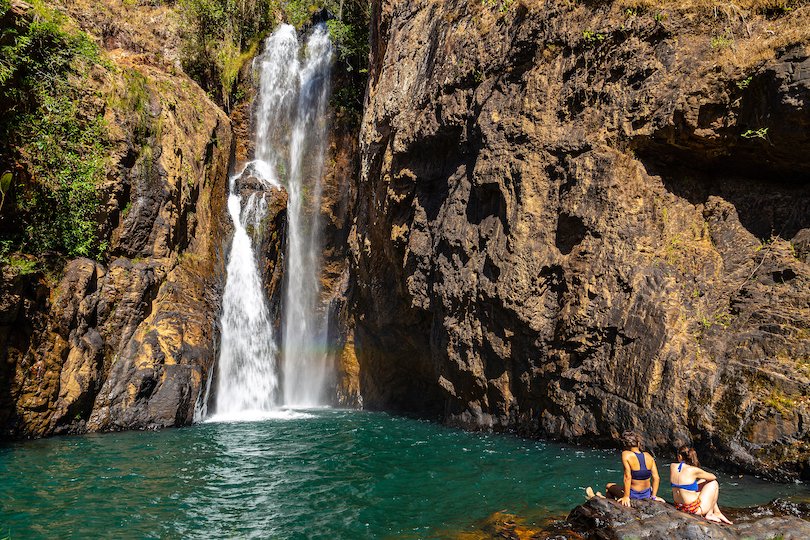
Chapada dos Veadeiros National Park is located at the heart of Goias and can be accessed through Sao Jorge and Alto Paraiso. The park sits on top of an ancient plateau that is estimated to be two billion years old. Visitors can explore the park’s stunning natural features such as cascading waterfalls, dipping valleys, and steep canyons through various hiking trails. One of the beginner-friendly trails is the Cachoeira Macaquinhos, or Little Monkey Waterfall, which is less than three miles long and offers breathtaking views of emerald-dipped pools and rushing waterfalls.
Don’t miss out on the Vale da Lua, an unusual rock formation that was shaped by erosion over millennia and is one of the park’s top attractions. Lastly, capture the perfect shot at the Mirante de Janela, a famous window frame-like landmark that provides sensational background views of Chapada dos Veadeiros National Park.
Jericoacoara
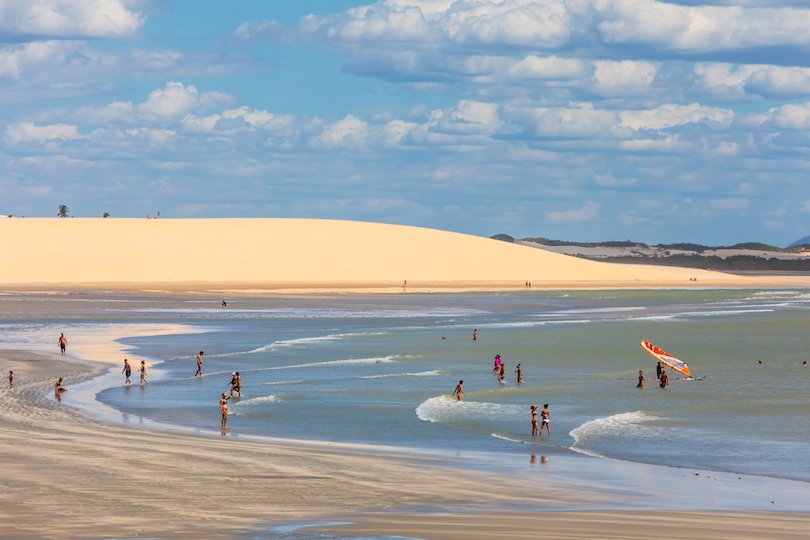
Jericoacoara, also known as Jijoca or Jeri, is a charming fishing village that has undergone a remarkable transformation into a vibrant beach resort destination. Located in Ceara, west of Fortaleza, this picturesque spot is a haven for water sports enthusiasts, offering activities such as windsurfing, kitesurfing, surfing, swimming, and backpacking.
What sets Jericoacoara apart is its unique atmosphere. The streets are not paved with cement, but rather with sand, blending seamlessly with the untouched coastlines adorned with vast sand dunes that seem to stretch endlessly.
A must-visit attraction in Jericoacoara is the renowned Jericoacoara National Park. Here, you can immerse yourself in the beauty of Lagoa do Paraiso, a breathtaking turquoise lagoon. Relax in the nearby hammocks, gently swaying in the breeze, or indulge in refreshments at the bars that dot the area. For a taste of the local cuisine, be sure to try the fresh lobster, oysters, and other delectable seafood dishes served at the charming local restaurants.
As the sun sets, Jericoacoara comes alive with a vibrant nightlife. Join the friendly locals and fellow tourists at the numerous clubs and bars, where live music fills the air, creating a magical ambiance that lasts well into the night.
Curitiba-Paranagua Train Ride
The renowned Serra Verde Express, Brazil’s most well-known railway, offers visitors the opportunity to embark on a journey aboard the Curitiba-Paranagua Train Ride, which traverses the southwestern region of the country.
Originally established by the Belgium-French company Chemin de Fer Bresilien, the Curitiba-Paranagua Railway was constructed with the aim of providing access to the port of Paranagua. This remarkable engineering feat of the 19th century took a total of five years to complete.
During this iconic scenic ride, passengers are treated to breathtaking views of magnificent landscapes. As the train winds its way through flourishing forests, ascends steep mountain slopes, follows meandering rivers, and passes by glistening lakes, the beauty of the surroundings unfolds before their eyes. Additionally, a highlight of the journey is the Veu de Noiva Waterfall, which gracefully cascades down a sheer rock formation, resembling a bridal veil.
Paraty
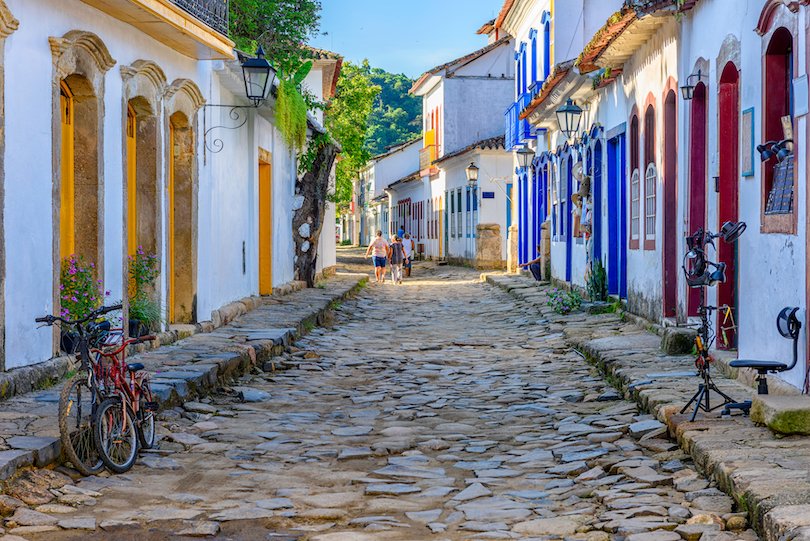
Paraty, a picturesque town nestled between Sao Paulo and Rio de Janeiro, boasts a breathtaking setting with majestic mountains as its backdrop, historic landmarks dotting its landscape, and a charming waterfront ambiance.
Once a bustling port during the Brazilian Gold Rush, Paraty has now transformed into a beloved tourist destination, captivating visitors with its natural beauty, Portuguese colonial architecture, and a plethora of activities to choose from.
However, the town’s cobblestoned streets offer more than just a glimpse into Paraty’s rich heritage. Take a leisurely stroll through Matriz Square, passing by quaint white houses adorned with vibrant doors and window frames, until you reach Santa Rita church. Immerse yourself in the local history, culture, and architectural marvels that this church has to offer.
For a truly rewarding experience, embark on the Mamangua Sugarloaf Peak Hike, leading you to the summit of Mamangua Peak. From here, you will be treated to a mesmerizing view of the world’s only tropical fjord, known as the Saco do Mamangua. To further explore the natural wonders of Paraty, grab a kayak and navigate through its mangroves, beaches, and coves, where you will witness the captivating allure that draws visitors from all corners of the globe.
Copacabana
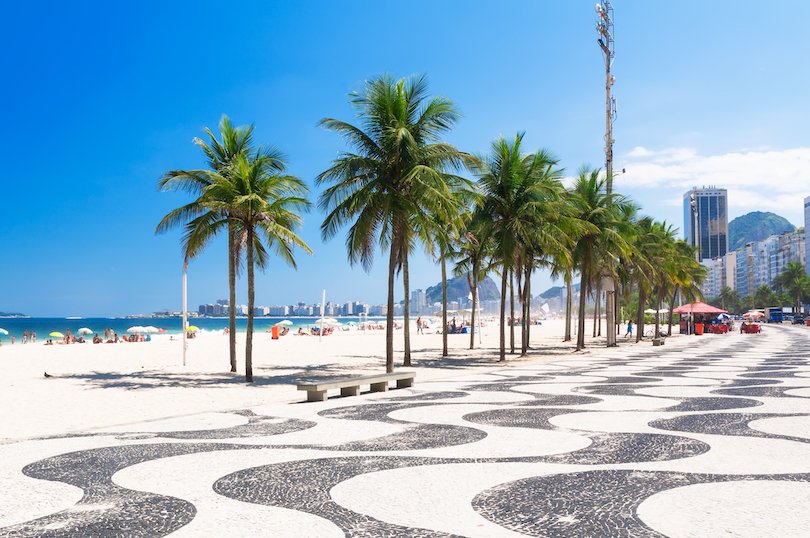
Copacabana, situated in Rio, is renowned globally as one of the most famous beaches. Stretching over a distance of around two miles, it is adorned with luxurious hotels and extravagant residences, interspersed with more humble dwellings. Alongside the sandy shore, a captivating boardwalk embellished with a striking black-and-white Portuguese stone pattern adds to its allure.
This locality is known for its lively atmosphere and is renowned for hosting Rio’s iconic New Year’s festivities. It also boasts various captivating tourist spots, such as the Copacabana Fort, built in 1914, and the luxurious Hotel Copacabana Palace.
Ouro Preto
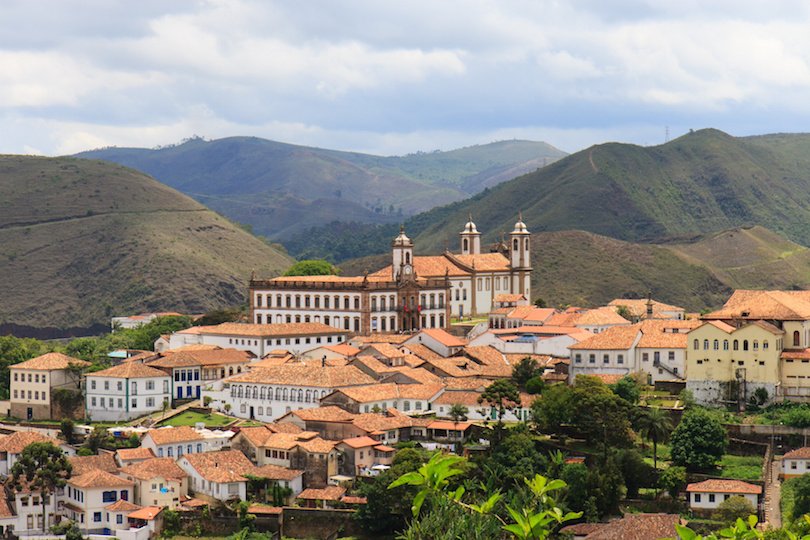
The Serra do Espinhaco mountains in northern Rio de Janeiro is home to the historic colonial town of Ouro Preto, known for its baroque architecture and cobbled streets. This town was established in the late 17th century and played a significant role in Brazil’s Gold Rush, becoming one of the wealthiest and largest towns. Aleijadinho, Brazil’s most renowned artist and sculptor, was born here, and his masterpieces can be found throughout the city, as well as in the Museum of Aleijadinho.
Visitors can also explore the world’s largest gold mine open to the public, located in Mariana, just outside of Ouro Preto. Guided tours take visitors through the mine on an old cable car while learning about its history. The town of Ouro Preto is also home to many stunningly designed churches, adorned with intricate designs and architecture, many of which were embellished with native gold.
Teatro Amazonas
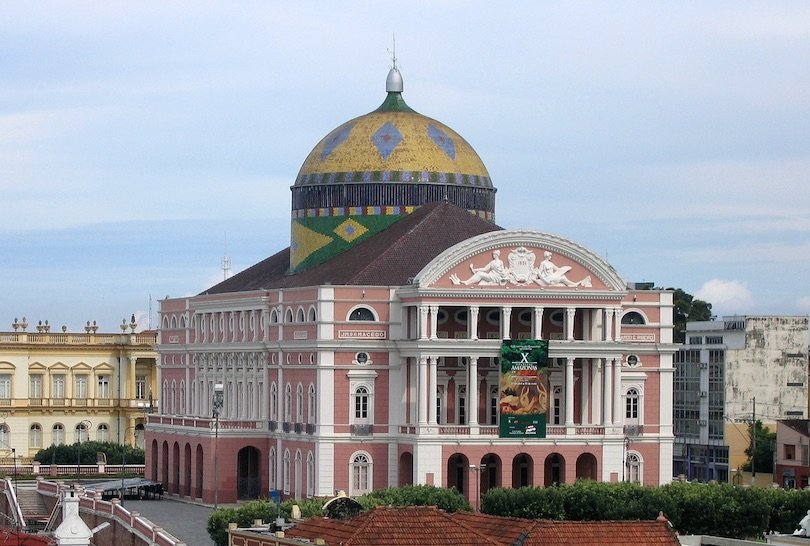
The Amazon Theatre, also known as Teatro Amazonas, is an opera house situated in the heart of the Amazon Rainforest in Manaus. It was constructed during the peak of the rubber trade and utilized materials from various parts of the world, including furniture from Paris, marble from Italy, and steel from England. The dome of the building is adorned with 36,000 ceramic tiles that are painted in the colors of the Brazilian national flag. The first show, La Gioconda, was performed on January 7, 1897. However, due to the decline of the rubber trade, the opera house was closed down shortly after. It remained unused for 90 years until it was reopened in 1990.
Fernando de Noronha
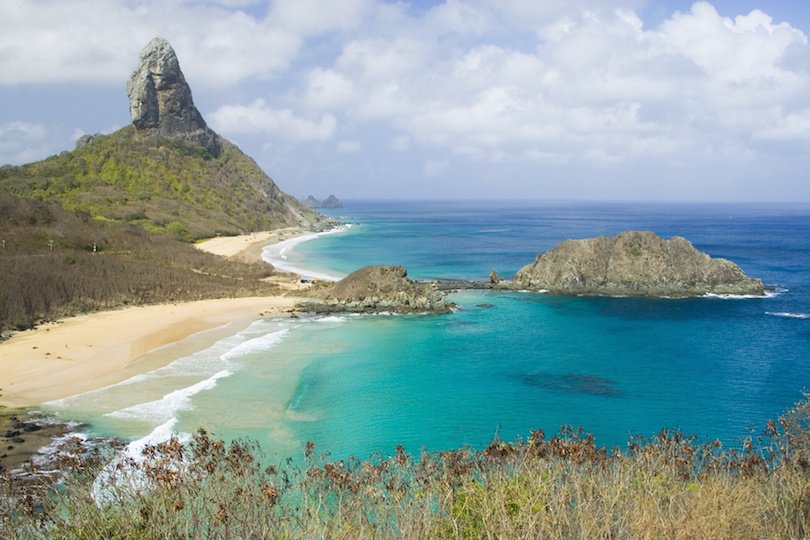
Fernando de Noronha, an exquisite archipelago located 354 km (220 miles) away from the northeastern coast of Brazil, boasts breathtaking beaches, picturesque landscapes, and diverse wildlife. This stunning archipelago was first discovered by Amerigo Vespucci in 1503 and experienced temporary occupations by the Dutch and French before Portugal established its dominion in 1737.
Presently, only the largest among the 21 islands is inhabited, accommodating a population of approximately 3,500 residents. With its warm waters throughout the year and exceptional visibility even at depths of 50 meters, these islands have become a haven for divers and snorkelers alike.
Bonito
Bonito, located in the Bodoquena Sierra of Mato Grosso do Sul, is a charming town that serves as a hub for ecotourism. The town is surrounded by lush forests and pristine waterways, with the Rio de Prata, or Silver River, being one of its most popular attractions. The river’s crystal-clear waters are home to a variety of friendly fish, making it an ideal spot for snorkeling.
Another must-visit destination in Bonito is the Gruta do Lago Azul, or Blue Lake Grotto. This surreal underwater cave is filled with blue water and is a popular spot for scuba diving, swimming, and snorkeling. Visitors may even stumble upon fossils of ancient prehistoric animals!
For a unique marine experience, head to Aquario de Natural, a marine preserve located just a short trek through the jungle. Here, visitors can enjoy swimming, snorkeling, and glass-bottomed boat tours, all while marveling at the vibrant-colored fish lazily swimming about in the clear waters.
Historic Center of Olinda
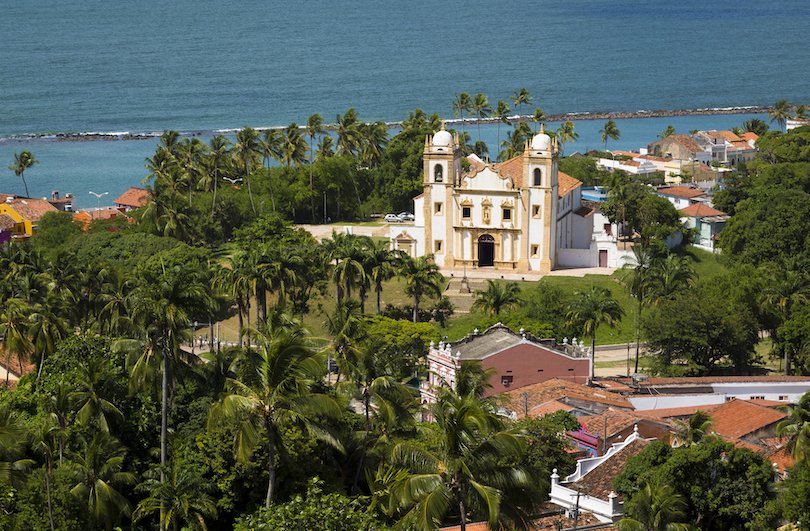
Located on the northeastern coast of Brazil in Pernambuco, north of Recife, lies the captivating city of Olinda. Founded in the 16th century, this city holds a significant place as one of Brazil’s most well-preserved colonial cities.
The Historic Center of Olinda is a sight to behold, with its remarkable architecture and lush greenery blending seamlessly with the picturesque ocean backdrop. The city’s roots are deeply intertwined with the sugarcane industry, and its historic center stands as a testament to the prosperity and opulence that fueled its growth during the 16th century. One prime example of Olinda’s architectural charm and prosperous past is the Catedral Alto da Se, a former Jesuit church.
Strolling through the Historic Center of Olinda is like embarking on a captivating journey through Brazil’s vibrant history. Every step unveils centuries-old monuments, churches, and houses that have stood the test of time.
Salvador Beaches
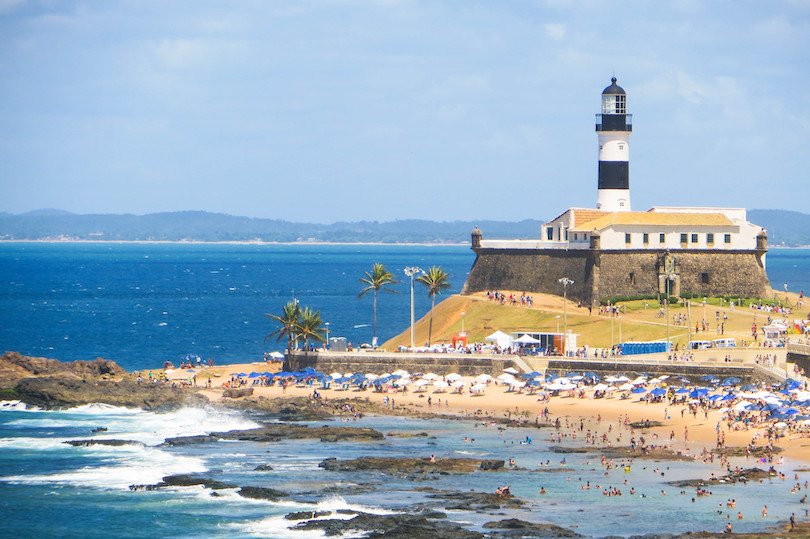
Salvador, the capital of Bahia in the northeast region of Brazil, boasts some of the most stunning beaches in the country. One such beach is Praia Itapua, a picturesque paradise adorned with fine white sand, swaying palm fronds, and coconut trees. Located near the vibrant and culturally diverse neighborhood of Itapua, this beach offers a unique blend of artistic charm and natural beauty.
Visitors can immerse themselves in the bohemian atmosphere of the nearby venues, which are known for their eclectic vibes, live music performances, and delectable food options. Don’t miss the chance to try “acaraje,” a spicy fried-bean dish that is sure to tantalize your taste buds.
For a lively beach experience, head to Boa Viagem, where you can join the locals in enjoying the beach strip lined with beachfront bars, nightclubs, and seafood restaurants. Take a leisurely stroll along the boardwalk, which offers breathtaking views of the beach. Boa Viagem is also an ideal destination for families, as the shallow waters protected by coral reefs provide a safe and enjoyable environment for children to have a fun-filled beach day.
With an abundance of beach options, Salvador truly offers something for everyone.
Pantanal
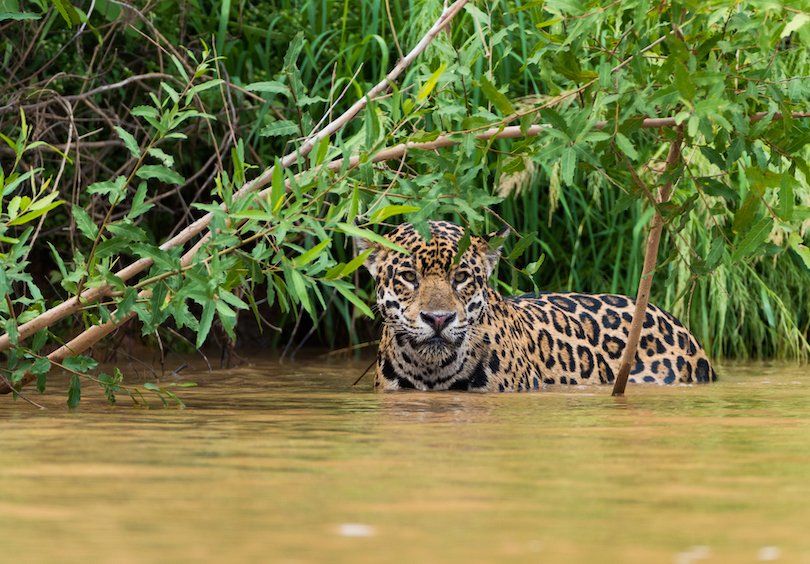
The Pantanal, located mostly in Mato Grosso do Sul, is the world’s largest flooded grasslands and tropical wetland area. It also extends into Bolivia and Paraguay.
Covering an area larger than 29 U.S. states and almost nine European countries, the Pantanal is a breathtaking natural wonder. It is a sanctuary for wildlife, with around 10 million caimans and jaguars that prey on them. The hyacinth macaw, the world’s largest parrot, can also be found here.
The Pantanal is home to a variety of incredible animals, including toucans and capybaras, attracting millions of tourists every year. Whether on horseback or in a canoe, there are many ways to explore this magnificent treasure of nature!
The Pantanal, situated mainly in Mato Grosso do Sul, is the largest flooded grasslands and tropical wetland area in the world. It also stretches into Bolivia and Paraguay.
Encompassing an area larger than 29 U.S. states and almost nine European countries, the Pantanal is a stunning natural marvel. It serves as a haven for wildlife, with approximately 10 million caimans and jaguars that prey on them. The hyacinth macaw, the world’s largest parrot, can also be found here.
The Pantanal is home to a diverse range of incredible animals, such as toucans and capybaras, attracting millions of tourists annually. Whether on horseback or in a canoe, there are numerous ways to explore this magnificent natural treasure!
Rio Carnival

Carnival festivities can be found in various parts of Brazil, with notable celebrations occurring in Recife, Olinda, and Salvador. However, the most renowned and grandest carnival undoubtedly takes place in Rio de Janeiro. The Rio Carnival draws in a staggering two million individuals daily, both locals and nearly half a million foreigners, during its four-day extravaganza.
The spirit of the Carnival permeates every nook and cranny of Rio, from the bustling streets and lively squares to the vibrant bars, clubs, and various other venues. The festivities culminate in the awe-inspiring Rio Samba Parade held at the iconic Sambadrome.
Amazon River
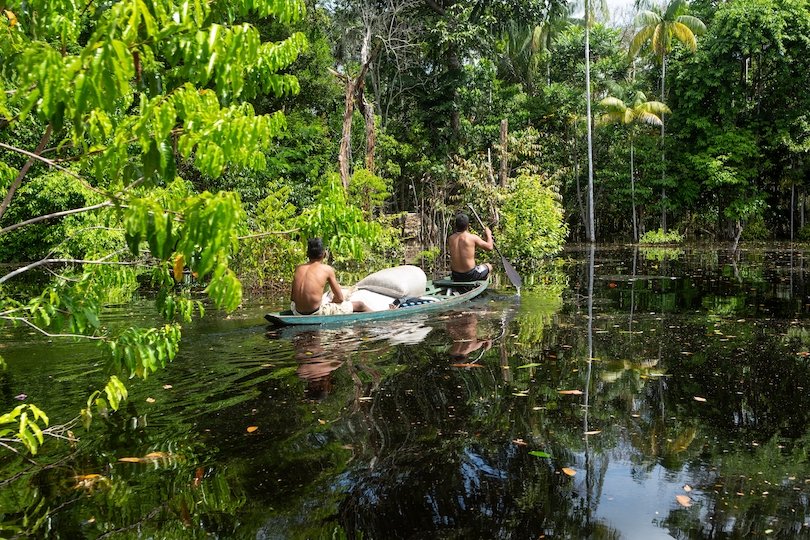
The Amazon River, known for its immense water volume, flows through nine countries in South America, including Brazil, Ecuador, Peru, and Venezuela. This remarkable river nurtures the largest rainforest on the planet, which remains largely unexplored, holding countless hidden treasures and opportunities. Situated in the northwestern region of Brazil, the city of Manaus stands as the sole urban settlement within the Amazon Rainforest, boasting a population exceeding one million inhabitants.
Tourists from around the globe flock to Manaus, enticed by the prospect of embarking on an extraordinary Amazon river tour or embarking on a thrilling backpacking expedition through the lush Amazonian jungles. These remarkable adventures offer a unique opportunity to witness the enchanting presence of sloths, toucans, macaws, and the extraordinary pinkish-hued river dolphin known as the boto.
Iguacu Falls
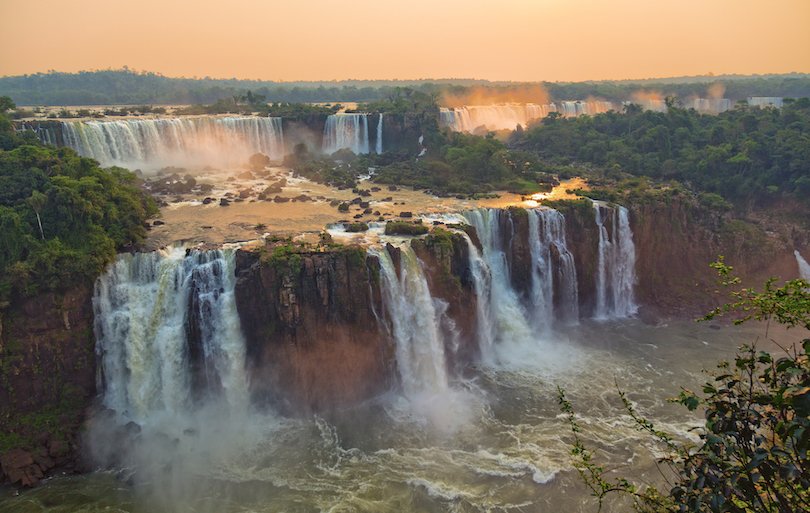
Iguaçu Falls, located on the border between Brazil and Argentina, is considered one of the most remarkable natural wonders in the world. This magnificent waterfall system consists of 275 falls that stretch along the Iguazu River. Among them, the most awe-inspiring is the Devil’s Throat, a U-shaped waterfall towering at a height of 82 meters (269 ft).
To access the falls, one can travel from the cities of Foz do Iguaçu in Brazil and Puerto Iguazú in Argentina, as well as from Ciudad del Este in Paraguay. On the Brazilian side, visitors can explore a lengthy walkway that runs along the canyon, offering breathtaking views and leading to the lower base of the Devil’s Throat.
Christ the Redeemer
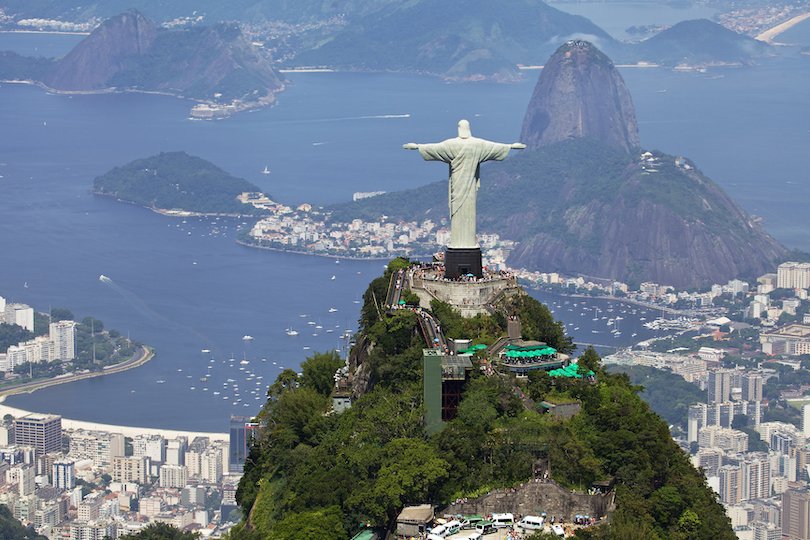
The Christ the Redeemer statue, a renowned symbol of Rio de Janeiro, has been recognized as one of the New Seven Wonders of the World since 2007. This iconic landmark, which has been standing for over 90 years, is not only Brazil’s most popular tourist attraction but also the largest Art Deco statue worldwide. Surprisingly, it ranks as the fourth tallest statue of Jesus Christ globally. Perched atop Corcovado Mountain, the statue captivates both religious devotees and non-believers, drawing millions of visitors who seek to witness its cultural significance firsthand.
Porto de Galinhas
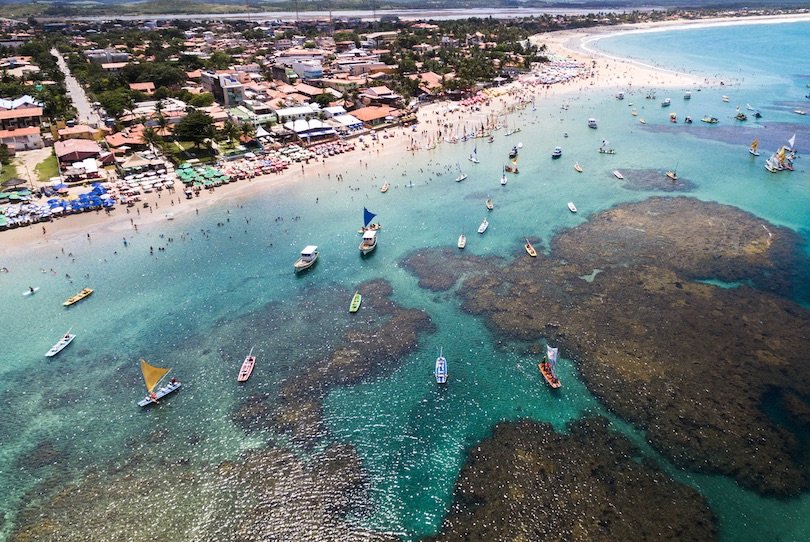
Located in the district of Ipojuca on the south coast of Pernambuco, Porto de Galinhas is a renowned beach town that boasts some of Brazil’s most famous beaches. The town is a sight to behold, with its stunning natural crystalline-clear pools, thriving reefs, and white-sugared beaches. The beach closest to the town center, Porto de Galinhas Beach, stretches on and on, and is dotted with restaurants and bars where visitors can grab refreshing drinks and fill up on food before indulging in snorkeling in waters full of tropical fish and soaking up the sun.
The natural pools in Porto de Galinhas are considered to be among the most popular attractions in the area. Formed naturally by the coral reef, these pools are teeming with vibrant marine life, making them a must-visit destination away from the sandy shores.
Campos do Jordao
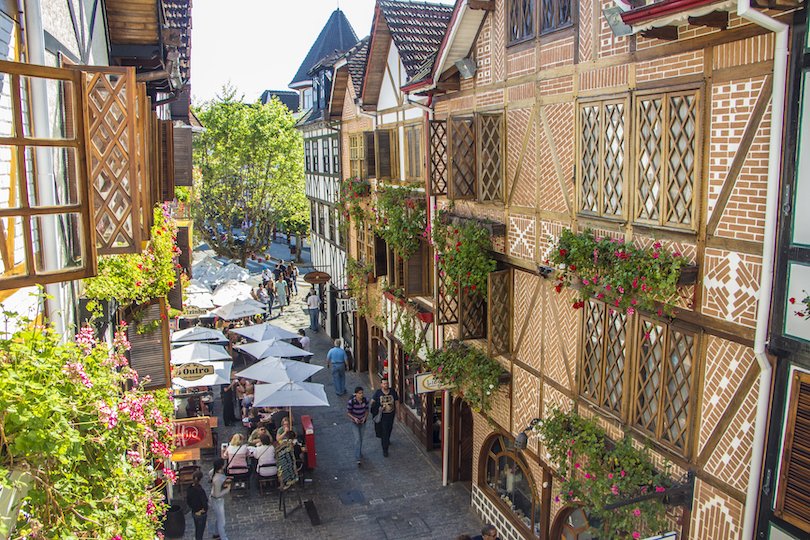
This town, often referred to as the Switzerland of Brazil, is situated at an altitude of over 1,600 meters (5,300 feet) in the stunning Mantiqueira Mountains. Due to its elevated position, this resort town provides a delightful retreat from the scorching Brazilian summer heat.
Campos do Jordao is renowned for its Winter Festival, a well-attended classical music event held in July that attracts musicians from across the globe. Additionally, this town is a popular destination for active tourists, offering a wide range of activities such as horseback riding, jeep tours, and cable car rides.
Lencois Maranhenses National Park
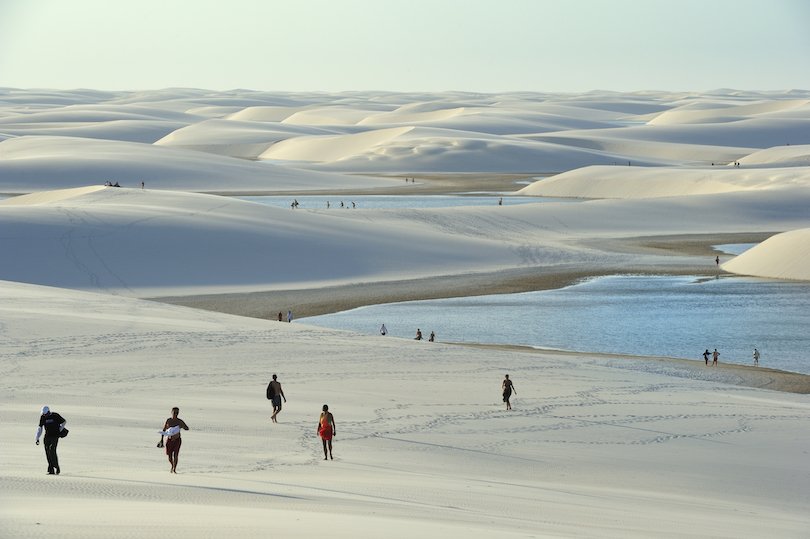
When people think of Brazil, they usually imagine beautiful beaches and lush forests, not sand dunes. However, Lencois Maranhenses, one of the country’s most fascinating national parks, boasts enormous dunes. It’s important to note that this isn’t a desert. In fact, heavy rainfall in July creates stunningly clear lagoons that can be as deep as 3 meters (10 feet) in some areas.
Interestingly, despite the fact that these pools are temporary and disappear during the dry season, they still contain fish. Swimming is permitted and is one of the most popular activities in Brazil, but visitors should be prepared for warm water. The temperature in these pools can reach as high as 30°C (87°F).







